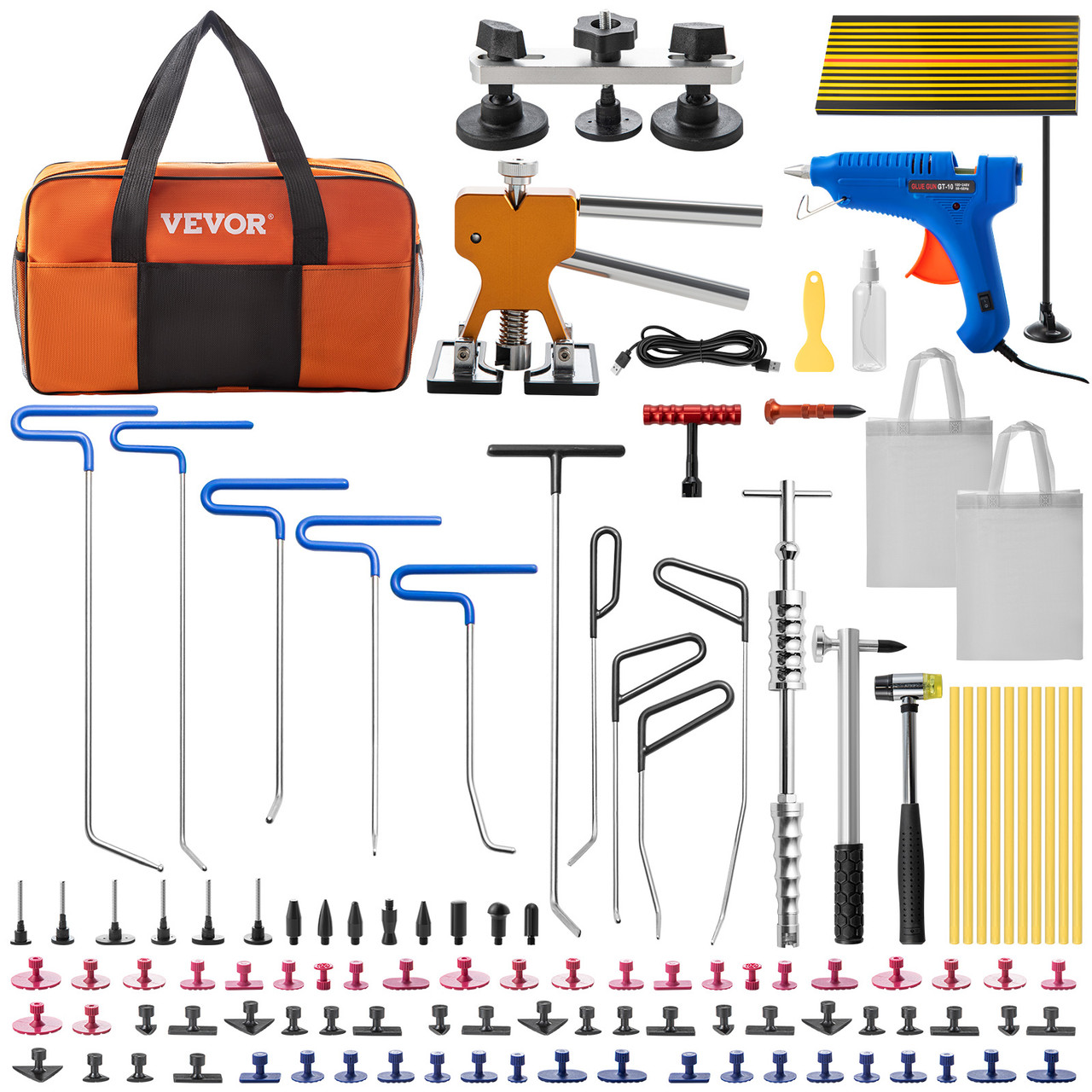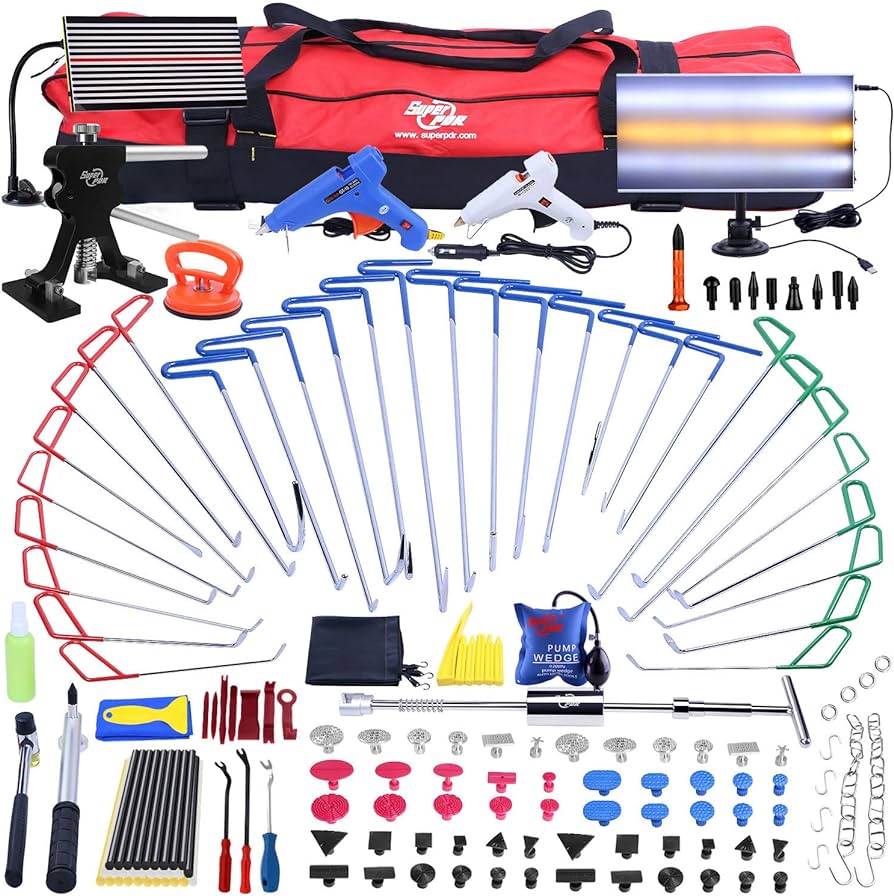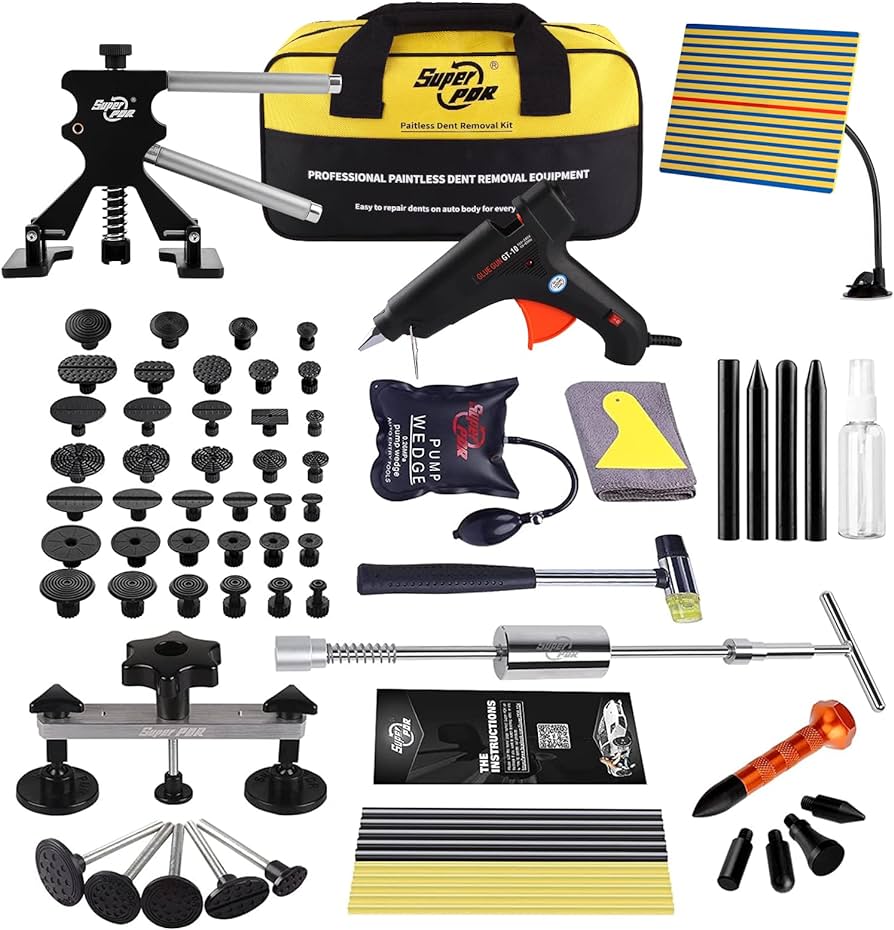In the realm of automotive maintenance, minor dents and dings can be a source of frustration for car owners. These unsightly blemishes not only detract from the vehicle’s appearance but can also lead to rust and further damage if left unattended. Fortunately, Paintless Dent Repair (PDR) Kits have emerged as a revolutionary solution, empowering individuals to restore their cars to their pristine condition without the need for costly body shop repairs.
This comprehensive guide delves into the world of Paintless Dent Repair Kits, equipping you with the knowledge and expertise to tackle those pesky dents and restore your car’s flawless finish. Whether you’re a seasoned DIY enthusiast or a curious novice, this guide will empower you to become a PDR master.

I. Introduction: Unveiling the Power of Paintless Dent Repair
Paintless Dent Repair, often abbreviated as PDR, has transformed the approach to addressing minor dents and dings in automobiles. This innovative technique eliminates the need for traditional body shop methods, such as sanding, filling, and repainting, which can be expensive, time-consuming, and potentially damaging to the original paint.
PDR kits provide a cost-effective and DIY-friendly solution for restoring car exteriors to their former glory. By utilizing specialized tools and techniques, these kits allow you to gently manipulate the dent from behind the panel, gradually coaxing it back into its original shape.
II. Understanding the Principles of Paintless Dent Repair
At the heart of PDR lies the concept of accessing the dent from behind the panel and applying controlled pressure to gradually reshape it. This approach differs from traditional methods that involve working directly on the dent’s surface, potentially altering the paint and compromising the vehicle’s value.
PDR kits typically employ a combination of tools to achieve this delicate process:
-
Dent Pullers: These versatile tools come in various shapes and sizes, allowing you to tackle dents of different depths and locations. They are used to apply pressure from behind the panel, gradually lifting the dent back into place.
-
Adhesives: Special adhesives are used to attach the dent puller directly to the dent, ensuring a secure grip during the repair process.
-
Heat Lamps: In some cases, heat lamps may be employed to soften the metal around the dent, making it more pliable and easier to manipulate.

III. Types of Paintless Dent Repair Kits: Catering to Diverse Needs
PDR kits are available in a variety of configurations to suit the needs of both experienced DIYers and those new to the technique:
-
Basic PDR Kits: Ideal for beginners, these kits typically include a selection of dent pullers, adhesives, and basic tools for tackling simple dents.
-
Intermediate PDR Kits: Designed for more experienced individuals, these kits offer a wider range of dent pullers, specialized tools, and accessories for addressing more complex dents.
-
Professional PDR Kits: Geared towards experienced PDR technicians, these comprehensive kits include a full arsenal of tools, specialized dent pullers, and advanced techniques for tackling even the most challenging dents.

IV. Choosing the Right Paintless Dent Repair Kit: Equipping Yourself for Success
When selecting a PDR kit, consider the following factors to ensure you have the right tools for the job:
-
Skill Level: Assess your experience and comfort level with DIY projects. If you’re a beginner, start with a basic kit and gradually progress to more advanced kits as your skills develop.
-
Dent Complexity: Evaluate the severity and location of the dents you need to repair. More complex dents may require specialized tools and techniques found in intermediate or professional kits.
-
Budget: Consider your budget and allocate an appropriate amount for a quality PDR kit. Remember that investing in a well-equipped kit can save you money in the long run compared to costly body shop repairs.
V. Essential Tools and Supplies for Paintless Dent Repair
Beyond the basic tools included in PDR kits, there are additional items that can enhance your repair experience:
-
Work Light: A bright work light ensures you have clear visibility of the dent and surrounding area during the repair process.
-
Protective Gloves: Protect your hands from sharp edges and potential skin irritation by wearing gloves.
-
Microfiber Cloths: Use soft microfiber cloths to clean the dent area and remove any adhesive residue.

VI. Setting Up and Using Paintless Dent Repair Kits: A Step-by-Step Guide
-
Preparation: Clean the dent area thoroughly to remove any dirt or debris. Next, Adhesive Application: Apply the adhesive to the dent puller, ensuring a secure and bubble-free attachment. Finally, Dent Puller Placement: Carefully position the dent puller directly over the dent, ensuring proper alignment and grip.
-
Pressure Application: Gradually apply pressure to the dent puller with a slow and steady pulling motion. Observe the dent as it begins to rise. It’s crucial to be patient and avoid using excessive force, which can cause further damage.
-
Heat Application (Optional): In some cases, applying heat from a heat lamp can be helpful for particularly stubborn dents. Heat relaxes the metal, making it more pliable and easier to manipulate back into its original shape. However, use caution and follow the manufacturer’s instructions for proper heat lamp usage to avoid overheating the paint.
-
Repositioning and Refinement: As the dent progresses, you may need to reposition the dent puller or use different sized tools to reach specific areas. It’s a process of gradual refinement, requiring patience and a keen eye for detail.
-
Adhesive Removal: Once the dent is mostly removed, carefully remove the dent puller by peeling off the adhesive. Use a microfiber cloth to clean any remaining adhesive residue from the repaired area.
-
Final Inspection: Thoroughly inspect the repaired area under good lighting to ensure the dent is completely gone. If minor imperfections remain, you may need to repeat the process with a smaller dent puller or utilize additional PDR techniques.

VII. Essential Tips and Techniques for Mastering Paintless Dent Repair
While PDR kits offer a user-friendly approach, mastering the technique takes practice and patience. Here are some additional tips to enhance your PDR skills:
-
Start with Simple Dents: Begin by practicing on shallow dents on inconspicuous areas to build your confidence and refine your technique before tackling more complex repairs.
-
Use the Right Tools for the Job: Select the appropriate dent puller size and shape based on the specific dent you’re repairing. Additionally, the wrong tool can hinder your progress or even cause additional damage. Furthermore, Apply Gentle and Controlled Pressure: Avoid using excessive force, as this can worsen the dent or damage the surrounding metal. Hence, patience and a light touch are key to successful PDR.
-
Practice Makes Perfect: The more you practice, the more comfortable and skilled you’ll become with PDR techniques. Utilize scrap metal panels to experiment with different dents and hone your skills before tackling repairs on your actual car.
-
Seek Professional Help for Complex Dents: If you’re unsure about repairing a particular dent or encounter significant challenges, don’t hesitate to seek help from a professional PDR technician.
VIII. The Advantages of Using Paintless Dent Repair Kits
PDR kits offer a multitude of benefits for car owners seeking to restore their vehicles’ flawless appearance:
-
Cost-Effective: Compared to traditional body shop repairs, PDR kits offer a significantly more affordable solution for addressing minor dents and dings.
-
DIY-Friendly: PDR kits are designed for user-friendliness, empowering individuals with the ability to tackle repairs themselves without extensive experience.
-
Painless Repair: Unlike traditional methods that involve sanding, filling, and repainting, PDR preserves the original paint job, maintaining the vehicle’s value.
-
Quick and Easy Repairs: PDR repairs can often be completed in a shorter timeframe compared to body shop repairs, minimizing downtime for your car.
-
Environmentally Friendly: By eliminating the need for sanding, repainting, and harsh chemicals, PDR is a more eco-friendly approach to car dent repair.
IX. Conclusion: Achieving Flawless Results with Paintless Dent Repair
Paintless Dent Repair Kits empower car owners to take control of minor dent repairs, restoring their vehicles to their pristine condition without breaking the bank. Additionally, by understanding the principles of PDR, selecting the right tools, and practicing proper techniques, you can achieve impressive results and maintain the value and beauty of your car.
X. Additional Resources to Enhance Your PDR Skills
-
Online Tutorials: Numerous online tutorials and video demonstrations provide visual guidance on using PDR kits and mastering different repair techniques. In addition, PDR Forums and Communities: Online forums and communities connect PDR enthusiasts, allowing you to exchange tips, troubleshoot challenges, and learn from experienced professionals. Further, Professional PDR Training: Consider enrolling in professional PDR training courses to gain advanced skills and tackle more complex dent repairs with confidence.
XI. Disclaimer: Embracing Safety and Realistic Expectations
While PDR kits offer a fantastic solution for many dents, it’s important to maintain realistic expectations. PDR may not be suitable for all types of dents, such as those with sharp creases, extensive damage, or located on body lines. Always prioritize safety and consult a professional if you’re unsure about repairing a particular dent.
By embracing safety precautions, utilizing the right tools and techniques, and understanding the limitations of PDR, you can unlock the potential of Paintless Dent Repair Kits and achieve impressive results in restoring your car’s flawless finish.
-
Leave a Reply